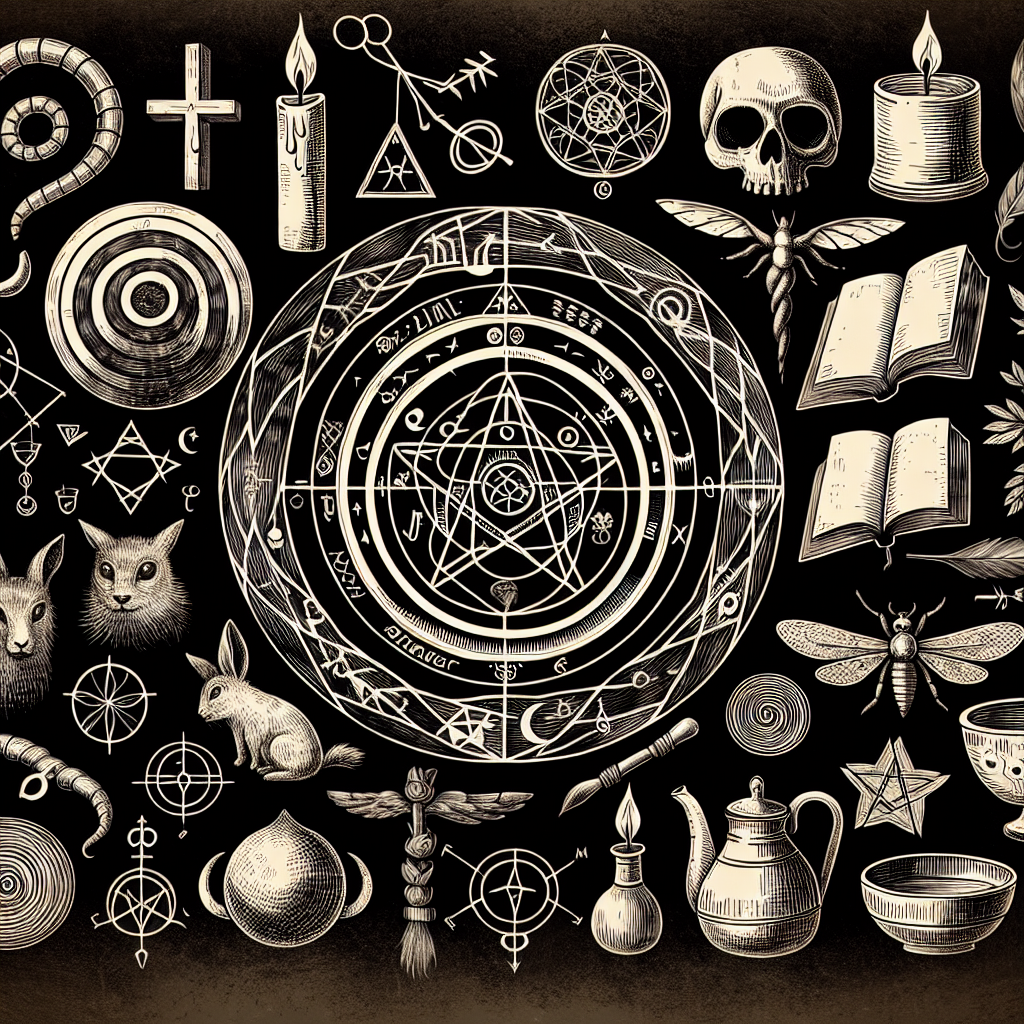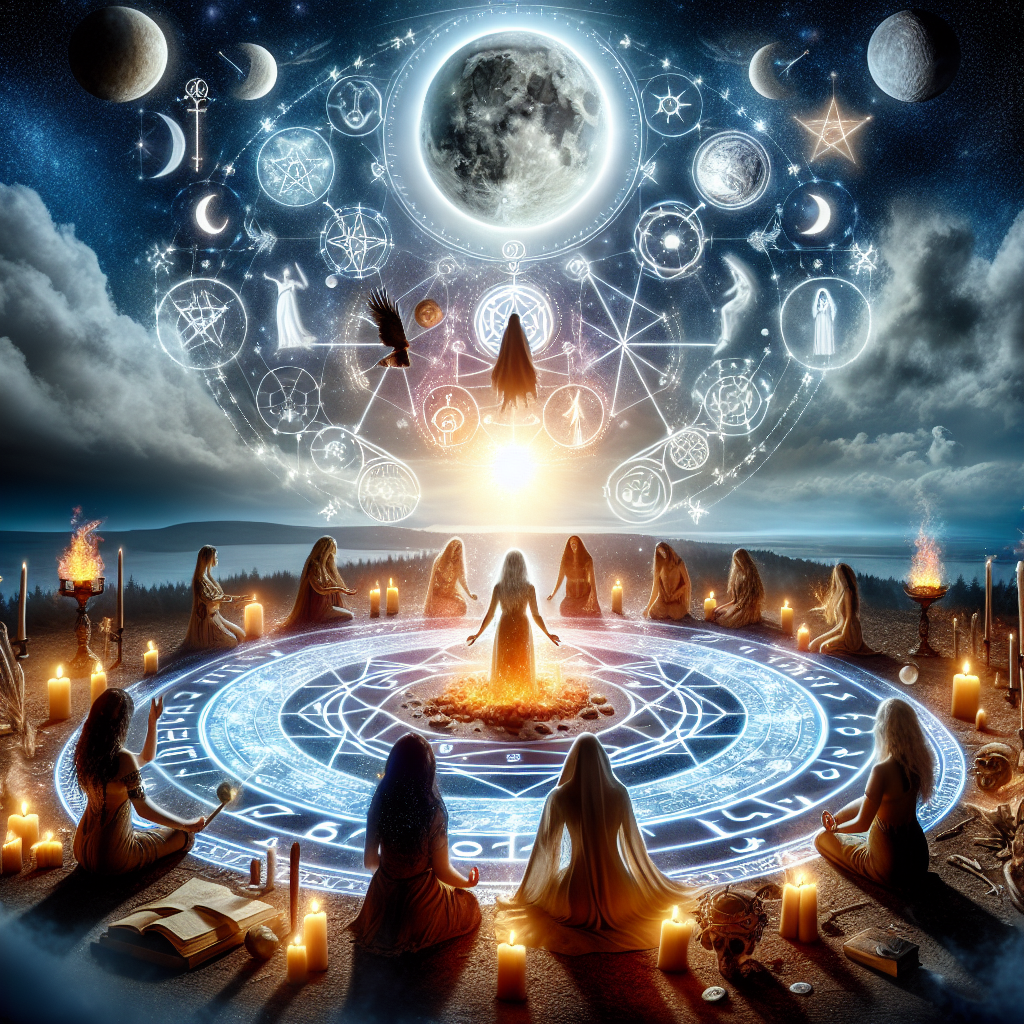As an Amazon Associate I earn from qualifying purchases.

Wicca, often perceived as a modern resurrection of ancient pagan religions, is a spiritual path that celebrates the divine in nature and the sacred feminine. It’s a religion that emphasizes ritualistic practice, ethical conduct, and a harmonious relationship with the Earth and all its creatures. Wicca’s birth is a relatively recent event in the vast timeline of spiritual practices, emerging in the mid-20th century.
The origins of the Wiccan religion can be traced back to the early 1950s in England, with a man named Gerald Gardner often credited as its founding father. Gardner was an English civil servant, an amateur anthropologist, and a passionate occultist, who professed to have been initiated into a coven of witches in the New Forest area in 1939. The core beliefs and practices of Wicca were largely shaped by Gardner’s influences, including ceremonial magic, the works of Aleister Crowley, as well as existing folklore and pre-Christian religious practices.
Remarkably, by the turn of the 21st century, scholars like Helen A. Berger posited that anywhere between 200,000 to 800,000 people in the United States alone identify as Wiccan or engage in Wiccan practices. This statistic showcases the swift expansion from its roots in mid-century England to a globally recognized spiritual path. Participants of Wicca celebrate the seasonal festivals known as Sabbats, perform rituals under the phases of the Moon, and adhere to the Wiccan Rede, a statement that advises practitioners to “harm none” with their actions.
The development of Wicca was influenced by earlier esoteric traditions, but it wasn’t until Gardner published his seminal works, such as “Witchcraft Today” (1954) and “The Meaning of Witchcraft” (1959), that the religion began to gain a public profile. The spread of Wiccan practices and beliefs was furthered by the repeal of the United Kingdom’s Witchcraft Act in 1951, which decriminalized the practice of witchcraft. This legal reform allowed Gerald Gardner and others to more openly practice and promote their spiritual beliefs.
Without the constraints of a centralized religious structure, Wiccan practices have diversified significantly. Numerous traditions now exist under the Wiccan umbrella, including but not limited to Gardnerian Wicca, Alexandrian Wicca, and Dianic Wicca, each with its own specific rituals and approach to divinity. This plurality within the Wiccan tradition emphasizes the religion’s focus on personal spiritual experience and growth.
The Wiccan religion, grounded in its reverence for nature and the Goddess, has also been noted for its harmonious alignment with contemporary ecological movements and feminist spirituality. It reflects a collective yearning for a spiritual practice that is intimately connected to the Earth, one that seeks to balance the interrelationship between human beings and the natural world, highlighting the importance of environmental conservation and gender equity in the realm of spirituality.
While Wicca continues to grow and change, adapting to the evolving spiritual landscape of the modern world, its foundations in the mid-twentieth century remain a pivotal point in the history of contemporary religious movements. As it forges ahead, Wicca holds a unique space in the religious tapestry, blending ancient themes with modern sensibilities and fulfilling the spiritual needs of its diverse, global community of practitioners.
“`html
Exploring the Origins of Wicca: When Did the Wiccan Practice Begin?
“`
Modern Wicca largely began in the early to mid-20th century, with its foundations attributed to the English civil servant and occultist Gerald Gardner. He claimed to have been initiated into a New Forest coven, and subsequently introduced what he termed ‘Witchcraft’ to the public in 1954 with his book, “Witchcraft Today”. Wicca draws from older pagan traditions, as well as 19th and 20th-century occultism, with elements including reverence for nature, the practice of magic, and the worship of a god and goddess. The development and spread of Wicca have been a complex interplay of original teachings, evolving beliefs, and individual practices, which we will explore further in the following sections to understand how Wicca established itself as a prominent contemporary religion.
When did Wiccan religion start? The roots of Wicca or modern Witchcraft can be traced back to the early 20th century, with its formal founding generally attributed to the 1950s in England. Gerald Gardner, often referred to as the father of modern Wicca, played a pivotal role in introducing the religion to the public domain. Gardner, a British civil servant, and amateur anthropologist, claimed to have been initiated into a coven of witches in the New Forest region in 1939, where he learned ancient pagan practices.
It wasn’t until 1954, after the repeal of England’s Witchcraft Laws, that Gardner published his foundational book “Witchcraft Today,” in which he outlined the basic tenets of the religion. Wicca combines esoteric hermetic and occult elements with ancient European pagan rituals, which Gardner claimed had survived in secret for centuries. In the years following the publication of his work and other writings, Wicca began to spread beyond the circles Gardner initiated, gaining followers and evolving as it did.
Gardner’s Wicca drew from various sources, including ceremonial magic, the teachings of Aleister Crowley, folklore, and the rituals of Freemasonry. He also incorporated the concept of a Goddess and a Horned God, representing the dual aspects of femininity and masculinity, as central deities worshiped by practitioners. The religion is markedly decentralized, with a strong emphasis on individual experience and the autonomy of covens, which are the basic organizational units of Wiccans.
The 1960s and 1970s saw an upsurge in the popularity of Wicca and related forms of contemporary Paganism, particularly in the United States and the United Kingdom, during a period of broader counter-cultural and spiritual exploration. This era ushered in the creation of numerous new traditions within Wicca, such as the Alexandrian Wicca, founded by Alex Sanders and his wife Maxine, which also gained a considerable following.
Wicca’s central rites include celebratory rituals for Sabbats coinciding with seasonal changes and the phases of the moon known as Esbats. These practices are designed to attune participants to the natural rhythms of the earth and the universe. Furthermore, magical work, a respect for nature, and a belief in the psychic and spiritual powers of the self are core components of Wiccan spirituality.
As for its influences, although Gardner claimed that Wicca was a direct continuation of pre-Christian pagan religions, scholars and historical evidence suggest that Wicca is more accurately described as a new religious movement inspired by such ancient practices, rather than a direct survival of any one tradition.
Today, Wicca has diversified into many different paths and traditions, each with their variations in practice and belief. Statistics on the size of the Wiccan population are difficult to ascertain due to the religion’s personalized nature and the fact that practitioners often do not openly declare their faith. However, according to the Pew Research Center’s Religious Landscape Study, approximately 0.4% of Americans identify as Wiccan or Pagan, which translates to roughly a million individuals in the United States embracing these spiritual paths as of the most recent surveys. This figure highlights how Wicca has grown from its inception in the mid-20th century to a widely practiced religion today.
“`html
1. What is Wicca and where did it originate?
Wicca is a modern Pagan religion that draws upon a diverse set of ancient pagan beliefs, as well as 19th and 20th-century hermetic motifs. It originated in the mid-20th century in England and was developed by figures such as Gerald Gardner and Doreen Valiente.
2. Who is considered the founder of Wicca?
Gerald Gardner is commonly regarded as the founder of Wicca. He played a pivotal role in formulating its principles and practices, and introduced Wicca to the public in the 1950s.
3. When was the Wiccan religion officially established?
The Wiccan religion was officially established in the 1950s after Gerald Gardner first published his book “Witchcraft Today” in 1954, which revealed Wiccan practices to the world.
4. Are there any historical texts that influenced the creation of Wicca?
Yes, Wicca was influenced by historical texts such as the “Key of Solomon,” various grimoires, and the writings of figures like Aleister Crowley. Margaret Murray’s theory of a pan-European witch-cult and Charles Leland’s “Aradia, or the Gospel of the Witches” also played influential roles.
5. What role did Doreen Valiente play in the establishment of Wicca?
Doreen Valiente was a close collaborator of Gerald Gardner and is often referred to as the “mother of modern witchcraft.” She helped refine and write much of the early Wiccan liturgical material, and her contributions were essential in shaping the Wicca we know today.
6. How does Wicca relate to older pagan religions?
Wicca is inspired by pre-Christian pagan religions of Europe and incorporates elements from these ancient belief systems, though it is a distinct, modern faith that was created in the 20th century.
7. Has Wicca evolved since its inception in the 1950s?
Yes, since its inception, Wicca has evolved significantly, diversifying into various traditions and practices. While some Wiccans adhere closely to Gardner’s original teachings, others have developed eclectic or solitary forms of the religion.
8. Can Wicca be considered a continuation of ancient witchcraft practices?
While Wicca draws inspiration from what is believed to be ancient witchcraft practices, it is a modern creation. It is not a direct continuation of any one historical tradition but a syncretic religion that incorporates various elements of older spiritual practices.
9. What is the significance of 1951 to the Wiccan religion?
The significance of 1951 to the Wiccan religion is that it marked the repeal of the Witchcraft Act in England, which allowed for the resurgence of practices related to witchcraft without the fear of prosecution. This legal change paved the way for Gerald Gardner to bring Wicca to the public eye.
10. How did the New Forest coven impact the development of Wicca?
The New Forest coven is believed to be the group that initiated Gerald Gardner into witchcraft, and thus it had a direct impact on his formulation of Wicca. Gardner claimed that the coven’s practices were rooted in an ancient witchcraft tradition, which he later adapted and publicized as Wicca.
“`
Conclusion
The roots of Wicca can primarily be traced back to the early 20th century with its formal inception occurring in the mid-20th century, spearheaded by Gerald Gardner. Gardner introduced Wicca to the public in the 1950s after the repeal of the Witchcraft Act in England, but the foundations were laid earlier through his involvement with various occult and esoteric societies. Wicca’s emergence was indeed a product of a complex interplay of Gardner’s experiences, pre-existing pagan practices, and the revival of interest in occultism and nature spirituality during that era. The religion evolved to become a blend of ancient folklore, esoteric knowledge, magical practices, and a celebration of nature, heavily imbued with symbolism and ritualistic traditions that appealed to a post-war generation seeking spiritual freedom and reconnection with the natural world.
Wicca’s development since its inception has seen significant diversification with the birth of various traditions and interpretations, reflecting its decentralized and experiential nature. This expansion shows its resilience and adaptability as a religion, enabling it to thrive globally in the modern religious landscape. Understanding the start of Wicca is not merely about pinpointing a date or individual but recognizing the confluence of historical and social dynamics that gave rise to a new, influential spiritual path. Wicca’s history, albeit comparatively short, is a testimonial to its lasting influence and continuing evolution amongst spiritual seekers who find solace and empowerment in its teachings and practices.
Amazon and the Amazon logo are trademarks of Amazon.com, Inc, or its affiliates.


